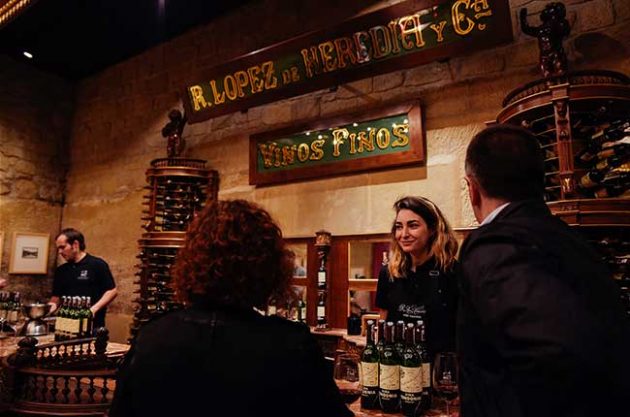And you don't even have to drive...
Haro wine festival
- The next Haro Station Wine Experience will be in June 2018
- The nearest airport is Bilbao, and Haro is approximately a one hour drive from there.
La Cata del Barrio de la Estación, the Haro Station Wine Experience, is Haro’s fine wine festival organised by seven classic wineries built around the train station.
The Haro Train Station Wine Quarter is home to the highest concentration of century-old wineries in the world, all just a short walk from each other.
Just as the fame of Bordeaux and its wines spread thanks to its port, Haro became a point of reference in the wine world thanks to its train station.
Until the late 19th century transport was painfully slow – wine hauled by mules and carts to Bilbao, more than 100km from Haro, and then exported by ships.
Trains, and its own station, gave Haro direct access to world markets, and put Rioja on the fine wine map.
Canny French investors got behind the development of incredible bodegas all around the station to speed trade. From the very beginning, they intended to produce fine wine. And they succeeded.
The Haro Train Station Wine Quarter is home to the highest concentration of century-old wineries in the world, all just a short walk from each other.
R López de Heredia Viña Tondonia was created in 1877; Compañía Vinícola del Norte de España (CVNE) was founded in 1879; Gómez Cruzado in 1886; La Rioja Alta in 1890; and Bodegas Bilbaínas in 1901.
Two younger siblings make up the ‘Magnificent Seven’: Bodegas Muga was founded in 1932, moving to Haro in 1970, and Bodegas Roda, the baby, came to the district in 1987, building its winery on top of an old cellar.

Packed schedule
Each winery is open for visits throughout the year, receiving on average more than 120,000 visitors. But during the La Cata festival the seven band together to enable attendees to visit them all in one day – they get support from the city council, which closes the quarter to traffic during the festival.
As well as the chance to taste the wines, renowned restaurants from the region produce delicious, sophisticated tapas to accompany the wines.
The day also includes musical performances, and each winery organises a cultural activity.
In 2016, R López de Heredia Viña Tondonia held a ‘Historical Exhibition’, with photographs and other artefacts relating the winery’s past. CVNE organised ‘Caro at CVNE’, a selection of sculptures distributed around the winery created by Anthony Caro, one of the leading British artists of the 20th century. Gómez Cruzado presented ‘Wine craftsmen: the wineskin maker’, an exhibition of the trade in goatskin flasks and wineskins for transporting and drinking wine.
La Rioja Alta displayed how to undertake manual racking by candlelight, an ancient technique to separate sediments from the wine; while Bodegas Bilbaínas demonstrated how to disgorge cava (the sparkling wine can be made in a number of wineries in Rioja).
Bodegas Muga, one of the last wineries in Spain with its own barrel-making facility, explained how to bend barrel staves in order to make a barrel. And Roda showed off its unique cellar.

More to do in Haro
It’s a one-day festival for the public, so the perfect excuse to combine a trip to Haro with visits to some remarkable places in the Rioja area.
For those focused on wine, there is the exceptional Vivanco Museum of Wine Culture – arguably the best wine museum in the world – with a collection from Egyptian art to Picasso, and anything imaginable in between.
Another popular and traditional wine festival in Haro is organised around the Feasts of St Peter and St Paul on 29 June. It gets world attention because of the famous Batalla del Vino ‘wine battle’.
Taking a broader perspective, the Suso and Yuso monasteries are the cradle of the Spanish language, and are also on the UNESCO World Heritage list.
The town of Santo Domingo de la Calzada is a major milestone on the pilgrimage route to Santiago de Compostela and boasts an impressive cathedral, while Ezcaray and several places in Sierra Cantabria offer great trekking experiences. All of this, combined with incredible wines and delicious food.
It’s certainly worth planning a visit to Rioja and Haro for the next Cata del Barrio de la Estación in June 2018 – if not before.
Pedro Ballesteros Torres MW is a DWWA Regional co-Chair for Spain and Sherry.
Edited for Decanter.com by Eleanor Douglas.
The full version of this article first appeared in Decanter magazine. Subscribe to Decanter here.
More wine travel:

Rioja festival goers soaked in 130,000 litres of red wine
Ten thousand people took part in the 'battle of wine' festival...

Wine festivals guide: Where to go in 2017
Plan your next holiday around one of these wine festivals held in picturesque regions...

How to visit Bordeaux’s 80m euro wine theme park – Cité du Vin

Burgundy to rival Bordeaux with own wine museums
A new tourism project for Burgundy...







